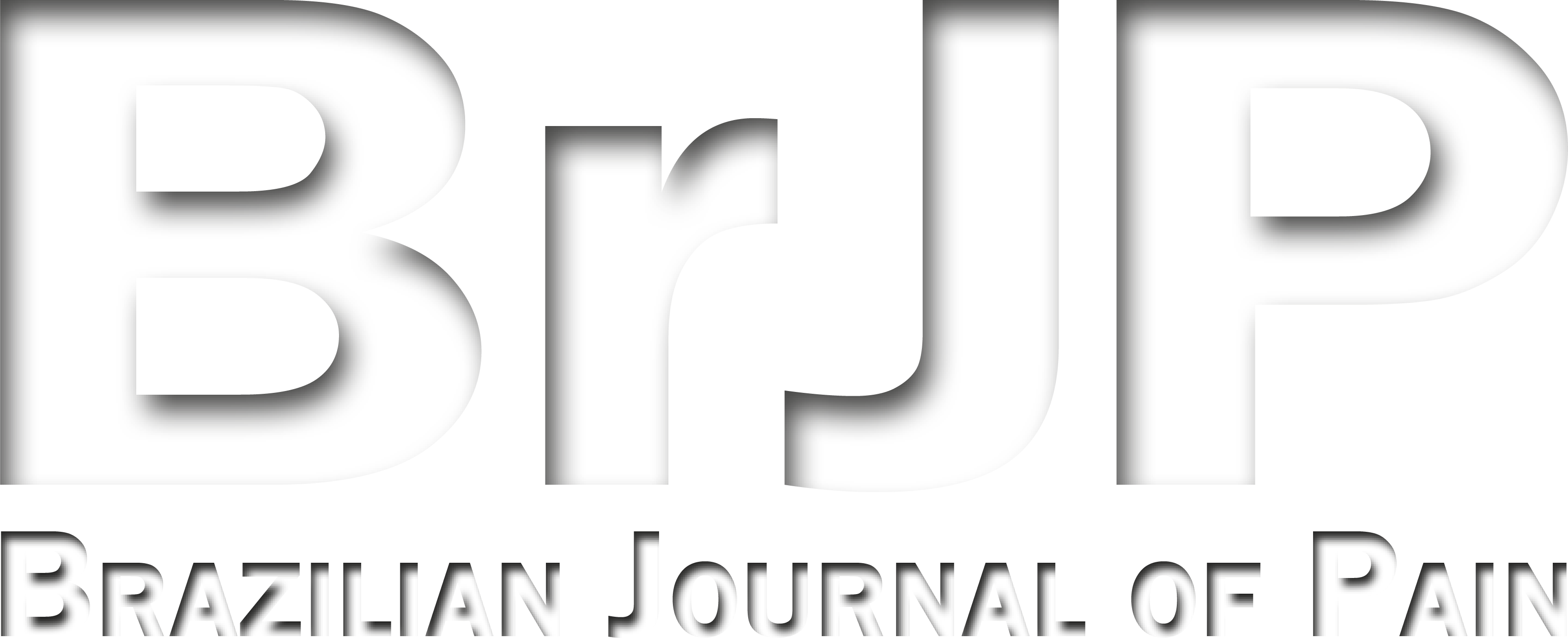Acupuncture in the treatment of temporomandibular muscle dysfunction
Acupuntura no tratamento da disfunção temporomandibular muscular
Evelyn de Freitas Boscaine; Elenir Rose Jardim Cury Pontes; Daisilene Baena Castillo; Lirane da Silva Carneiro Suliano; Nelson Talatoci Oshiro Filho
Abstract
Keywords
Resumo
Palavras-chave
References
Abouelhuda AM, Khalifa AK, Kim YK, Hegazy SA. Non-invasive different modalities of treatment for temporomandibular disorders: review of literature. J Korean Assoc Oral Maxillofac Surg. 2018;44(2):43-51.
Fonseca Alonso B, Nixdorf DR, Shueb SS, John MT, Law AS, Durham J. Examining the sensitivity and specificity of 2 screening instruments: odontogenic or temporomandibular disorder pain?. J Endod. 2017;43(1):36-45.
Garbelotti TO, Turci AM, Serigato JMA, Pizzol KE, Franco-Micheloni AL. Effectiveness of acupuncture for temporomandibular disorders and associated symptoms. Rev Dor. 2016;17(3):223-7.
Castillo DB, Azato FK, Coelho TK, Pereira PZ, Silva MG. Clinical study on head and jaw position of patients with muscle temporomandibular disorder. Rev Dor. 2016;17(2):88-92.
Maydana AV, Tesch RS, Denardin OV, Ursi WJ, Dworkin SF. Possible etiological factors in temporomandibular disorders of articular origin with implications for diagnosis and treatment. Dental Press J Orthod. 2010;15(3):78-86.
Torres F, Campos LG, Fillipini HF, Weigert KL, Vecchia GF. Efeitos dos tratamentos fisioterapêutico e odontológico em pacientes com disfunção temporomandibular. Fisioter Mov. 2012;25(1):117-25.
Grillo CM, Canales Gde L, Wada RS, Alves MC, Barbosa CM, Berzin F. Could acupuncture be useful in the treatment of temporomandibular dysfunction. J Acupunct Meridian Stud. 2015;8(4):192-9.
Okeson JP. Tratamento das desordens temporomandibulares e oclusão. 2013:101-29.
Zotelli VL, Grillo CM, Gil ML, Wada RS, Sato JE, da Luz Rosário de Souza M. Acupuncture effect on pain, mouthopening limitation and on the energy meridians in patients with temporomandibular dysfunction: a randomized controlled trial. J Acupunct Meridian Stud. 2017;10(5):351-9.
Silva HB, Soares JL. Análise da abordagem fisioterapêutica no tratamento da disfunção temporomandibular: revisão integrativa. REAS/EJCH. 2019;19:1-7.
Menezes MS, Bussadori SK, Fernandes KP, Biasotto-Gonzalez DA. Correlação entre cefaleia e disfunção temporomandibular. Fisioter Pesqui. 2008;15(2):183-7.
Franco AL, Zamperini CA, Salata DC, Silva EC, Albino Júnior W, Camparis CM. Fisioterapia no tratamento da dor orofacial de pacientes com disfunção temporomandibular crônica. Rev CubanaEstomatol. 2011;48(1):56-61.
Furlan RM, Giolvanardi RS, Britto AT, Britto DB. O emprego do calor superficial para tratamento das disfunções temporomandibulares: uma revisão integrativa. CoDAS. 2015;27(2):207-12.
Furlan RM. O uso da crioterapia no tratamento da disfunção temporomandibular. Ver Cefac. 2015;17(2):648-55.
Ferreira FM, Simamoto-Júnior PC, Soares CJ, Ramos AM, Fernandes-Neto . Effect of occlusal splints on the stress distribution on the temporomandibular joint disc. Braz Dent J. 2017;28(3):324-9.
Florian MR, Meirelles MP, Souza ML. Disfunção temporomandibular e acupuntura: uma terapia integrativa e complementar. Odontol Clín Cient. 2011;10(2):189-92.
Bontempo GG, Melo PB, Pizzol KE, Franco-Micheloni AL. Ear acupuncture associated to home self-care in the treatment of chronic temporomandibular disorders in women. Case report. Rev Dor. 2016;17(3):236-40.
Boscaine EF, Suliano LS, Pontes ER, Castillo DB, Moraes JL, Nascimento VA. Effects of acupuncture in the treatment of temporomandibular dysfunctions. Int J Develop Res. 2018;8(3):19294-7.
Brahim CB, Araújo JO, Queiroz DA, Dessaune Neto N, Tinelli D, Cury SE. Eficácia da técnica de agulhamento seco no controle da síndrome da dor miofascial: uma revisão crítica da literatura. Cadernos UniFOA, Volta Redonda. 2017:105-24.
Borin GS, Corrêa EC, Silva AM, Milanesi JM. Surface electromyography of masticatory muscles in individuals with temporomandibular disorder submitted to acupuncture. Rev Soc Bras Fonoaudiol. 2012;17(1):1-8.
Pereira MS, Silva BO, Santos FR. Acupuntura: terapia alternativa, integrativa e complementar na odontologia. R CROMG. 2015;19(1):19-26.
Shueb SS, Nixdorf DR, John MT, Alonso MT, Durham J. "What is the impact of acute and chronic orofacial pain on quality of life"?. J Dent. 2015;43(10):1203-10.
Costa A, Bavaresco CS, Grossmann E. The use of acupuncture versus dry needling in the treatment of myofascial temporomandibular dysfunction. Rev Dor. 2017;18(4):342-9.
Luiz AB, Babinski MA, Ferreira AS. Neurobiologia da analgesia induzida por acupuntura. Manual e eletroacupuntura: revisão de literatura. J Naturol Compl Ther. 2012;1(1):71-84.
Maciocia G. Os Fundamentos da Medicina Chinesa. 2014.
Porporatti AL, Costa YM, Stuginski-Barbosa J, Bonjardim LR, Conti PC. Acupuncture therapeutic protocols for the management of temporomandibular disorders. Rev Dor. 2015;16(1):53-9.
Ahmed NA, Poate T, Nacher-Garcia C, Pugh N, Cowgill H, Page L. Temporomandibular joint multidisciplinar team clinic. Br J Oral Maxillofac Surg. 2014;52(9):827-30.
Boleta-Ceranto DC, Alves T, Alende FL. O efeito da acupuntura no controle da dor na odontologia. Arq Ciênc Saúde Unipar, Umuarama (PR). 2008;12(2):143-8.
Catão MH, Oliveira PS, Costa RO, Carneiro VS. Evaluation of the efficacy of low-level laser therapy (LLLT) in the treatment of temporomandibular disorders: a randomized clinical trial. Ver Cefac. 2013;15(6):1601-8.
Wang B. Princípio de Medicina Interna do Imperador Amarelo. 2013:21-34.
Menezes MS, Bussadori SK, Fernandes KP, Biasotto-Gonzalez DA. Correlação entre cefaleia e disfunção temporomandibular. Fisioter Pesqui. 2008;15(2):183-7.
Souza LM, Silva IC. A utilização da acupuntura no tratamento da disfunção da articulação temporomandibular: sugestão para protocolo clínico. Acta de Ciências e Saúde. 2016;5(2):112-28.
Souza ML, Mashuda CS, Sato JE, Siqueira JT. Effect of acupuncture in adults with temporomandibular disorders. Rev Dor. 2014;15(2):87-90.
Camargo BA, Grillo CM, Souza ML. Temporomandibular disorder pain improvement with acupuncture: preliminary longitudinal descriptive study. Rev Dor. 2014;15(3):159-62.
Ferreira LA, Grossmann E, Januzzi E, Gonçalves RT, Mares FA, de Paula MV. Ear acupuncture therapy for masticatory myofascial and temporomandibular pain: a controlled clinical trial. Evid Based Complement Alternat Med. 2015;2015.
Zotelli VL, Meirelles MP, Souza ML. Uso da acupuntura no manejo da dor em pacientes com alterações na articulação temporomandibular (ATM). Rev Odontol Univ São Paulo. 2010;22(2):185-8.
Vicente-Barrero M, Yu-Lu SL, Zhang B, Bocanegra-Pérez S, Durán-Moreno D, López-Márquez A. The efficacy of acupuncture and decompression splints in the treatment of temporomandibular joint pain-dysfunction syndrome. Med Oral Patol Oral Cir Bucal. 2012;17(6):e1028-33.
Vera RMT, Grillo CM, Fortinguerra ML, Souza ML, Berzin F. Acupuncture to manage orofacial pain and tinnitus. Case report. Rev Dor. 2013;14(3):226-30.
Submitted date:
02/13/2019
Accepted date:
10/16/2019


